While online shopping, flexible business models, and cloud technologies have helped businesses extend their digital presence online, they have also made the competitive landscape challenging to navigate, with a lot of noise heading your customers’ way.
As a digital brand, you can’t rely on one-off, jaggy communications to connect with your customers. Instead, you need a dedicated voice that speaks the audience’s language, synchronizes with individual members, and resolves the core issues to help you stand out from the competition.
The best way to do that? Your company blog. Create blog posts surrounding problems the customers are facing and lend help to the target buyers.
That’s content marketing in a nutshell. That said, how often should you blog to be successful in your marketing efforts?
The short answer is: It depends on the audience, competition, and industry.
Still, you can find an exact, yet long, answer by looking into the factors that dictate the publishing frequency. We’ll do all that and more below. So, let’s dig in.
Why You Need To Publish Content Frequently
Your published content is a communication channel between your brand and potential customers. In that sense, your brand needs to push out regular content to nourish customer relationships — similar to how you communicate with your close friends to stay connected.
Plus, search engines also have a major say in how much you’ll get to converse with your target buyers. So, you must ensure your publishing frequency gives them what they’re asking for to get the most out of your search engine optimization (SEO) efforts.
Let’s break these concepts down to understand why content consistency is important.
Search Engine Optimization Relies on Consistent Content
Let’s start with SEO advice straight from the horse’s mouth: Google’s Senior Search Analyst John Mueller tweeted in 2021, “SEO lives & dies with consistency.”
John Mueller’s tweet makes perfect sense. Your website experiences ranking changes every day. You gain rankings for some keywords and lose rankings for others. To increase traffic, you must gain more keyword rankings than you lose.
And that’s what consistent content gets you. You get opportunities to rank for newer relevant keywords, resulting in more traffic.
In contrast, if you take a break from content creation, you don’t exploit the opportunity to gain rankings — while the competitors keep chipping away at your keywords, taking away traffic from you.
Data backs it up, too. One of The Blogsmith’s clients shifted their focus away from their blog for a year, and the results tell a fairly straightforward story.
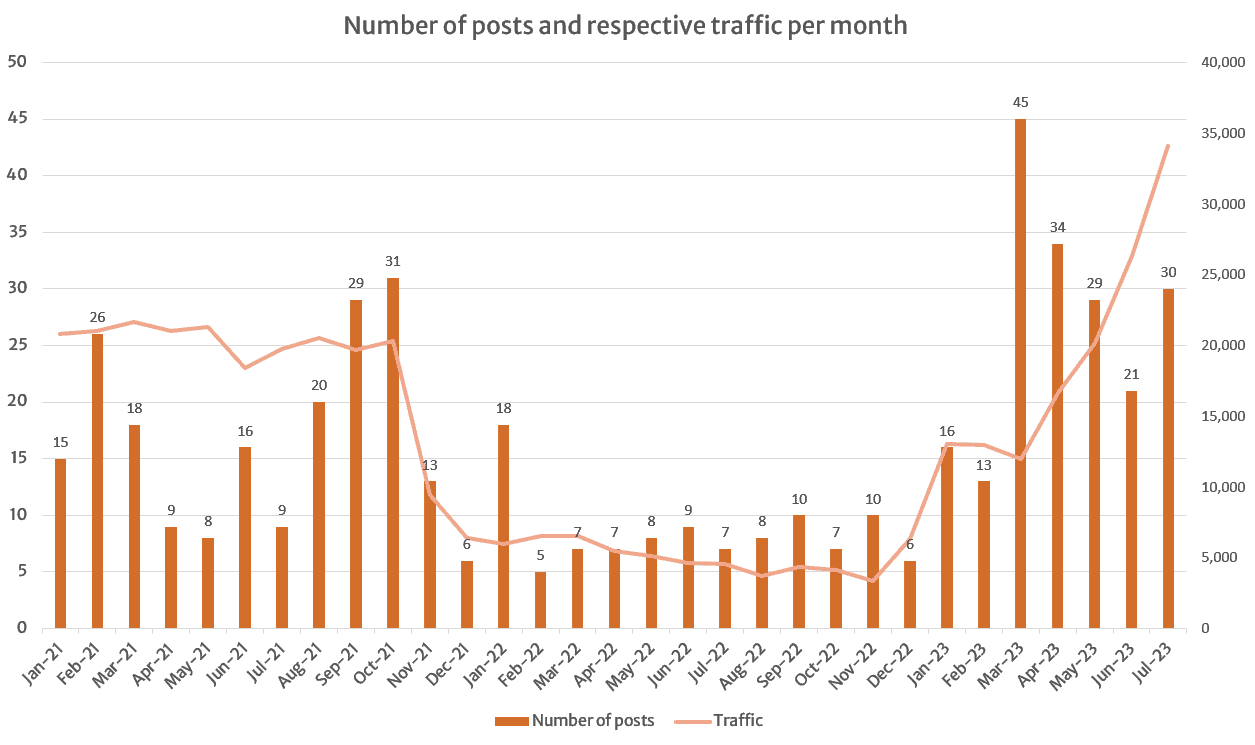
The client’s website experienced a sharp decline — from monthly organic traffic of about 20k to 3-5k a month — as they reduced their content creation efforts.
In essence, consistency is to search crawlers what catnip is to cats — irresistible! And you must keep this in mind when designing your SEO content strategy.
Search Engines Reward Fresh Content
Even if we ignore the fierce battle over keywords between competitors, internet users often look for fresh content. For example, when I enter “best ergonomic keyboard” in the search engine, I want to know about the best ergonomic keyboard of the current year (2023) — not 2022.
Ergonomic science may have changed over time, and I want to know about the best options at my disposal today.
Search engines understand this as well. For instance, according to section 18.0 of the Search Quality Rater Guidelines, Google checks whether a webpage contains recent content (i.e., recently published or updated) if the query requires recent or fresh information.

So, to rank for queries where readers are looking for the latest information, you must release blog posts rather frequently to stay on the front page of search engine result pages (SERPs).
Audiences Look for Authoritative Websites
While search crawlers matter, there’s also a human side of marketing that you might miss if you’re overly obsessed with search engines.
For example, say a user searches for “Gross profit.” They’ll see the following two results at the top:
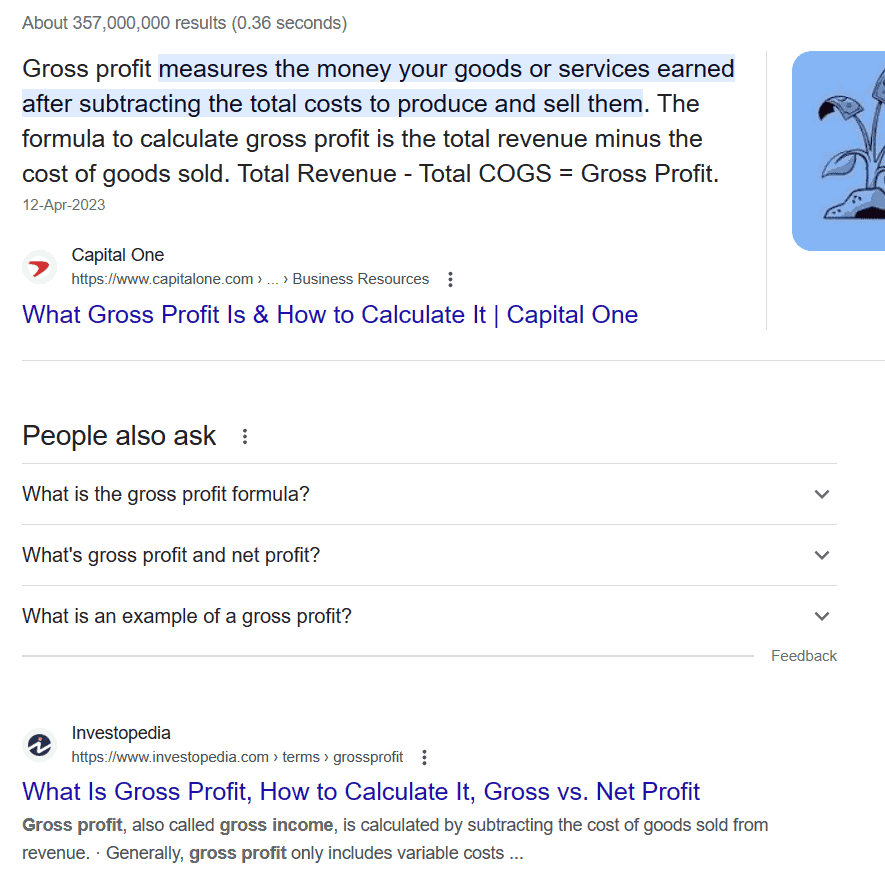
Capital One is at the top (position 0), which lends the brand some weight. But since Investopedia is a more globally-renowned brand, users might still opt for Investopedia’s take on gross profit over Capital One’s.
In that sense, if you can position yourself as an authority in your micro-niche, you may have a chance to defy the typical click-through rates by rank position — the chance of getting a user click depending on your rank on the search result page.
Similarly, consider RTINGS.com. While giants like TechRadar shed their traffic in the last few years, RTINGS.com attracted that shared audience by creating highly-relevant content.
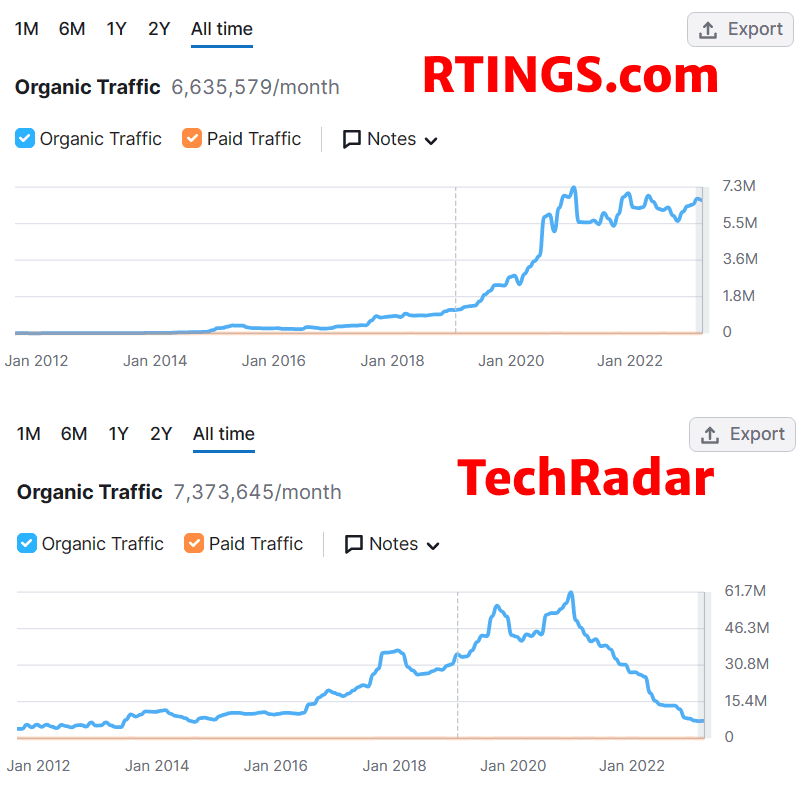
Instead of creating guides full of marketing buzzwords, RTINGS.com relies on objective testing and provides insights based on real-world applications for products the target audience wants, and it does so consistently by creating new posts and updating old blogs.
For example, here are the recent updates to RTINGS.com’s blog on the best ergonomic mouse, which as of writing, ranks at the first position for “best ergonomic mouse,” above blogs published by CNN, PCMag, and CNET.
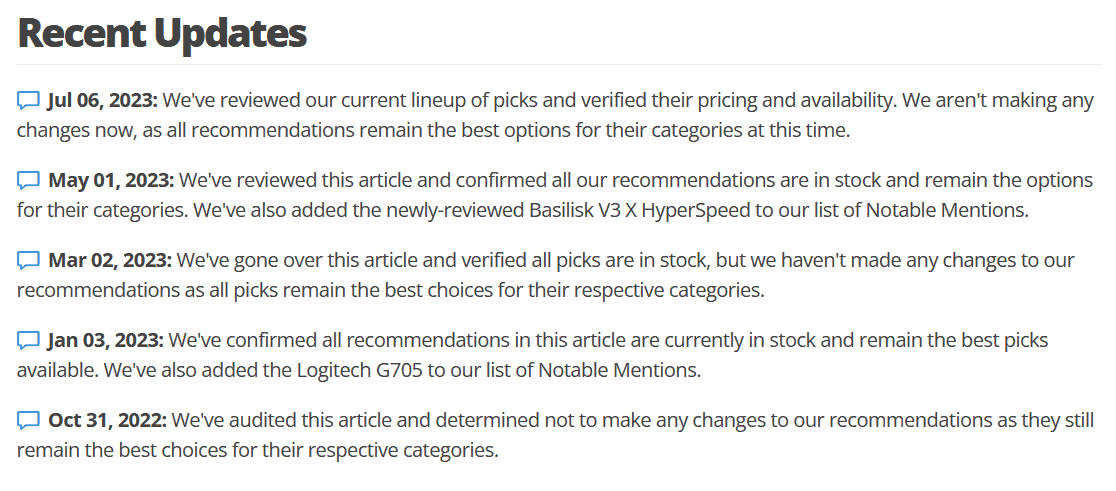
From the image, it appears that RTINGS.com reviews its recommendations every two months to see if something has changed, which seems like a good time frame because it gives its reviewers time to unravel the intricacies of a new tech product.
However, the level of content consistency required to come across as an authority looks different for everyone — and that brings us to:
How Often Should You Blog?
The magical number that applies to most businesses is 2-4 blogs per week. But if you’re looking for a concrete number specific to your business, it depends — typically on factors like your target audience, industry, and competitive landscape.
If your target audience has several questions about your products or services and your industry regularly experiences disruptive changes, you may stick with a content frequency of 4-5 blogs per week. Examples include SaaS businesses, web development agencies, and web hosting companies.
And if you’re a blogger who manages a news-focused website, take it up a couple of notches to multiple posts a day to keep up with news cycles.
In contrast, if you operate in a specialized industry, you can turn to content creation once or twice a month. For example, if you sell luxury watches, a couple of monthly posts detailing your watches’ craftsmanship can help you engage the target audience.
Notice a pattern? The appropriate content frequency depends on the business.
To determine which content frequency applies to your business, let’s navigate the common factors that affect content frequency.
Target Audience
Does your audience prefer short chunks of content over the week or an in-depth guide once a month? Use website analytic tools and competitor analysis tools to find your answer.
For example, suppose you run a business management platform and NetSuite is your competitor. In that case, you can use BuzzSumo to see how frequently NetSuite publishes content and the content the audience prefers.
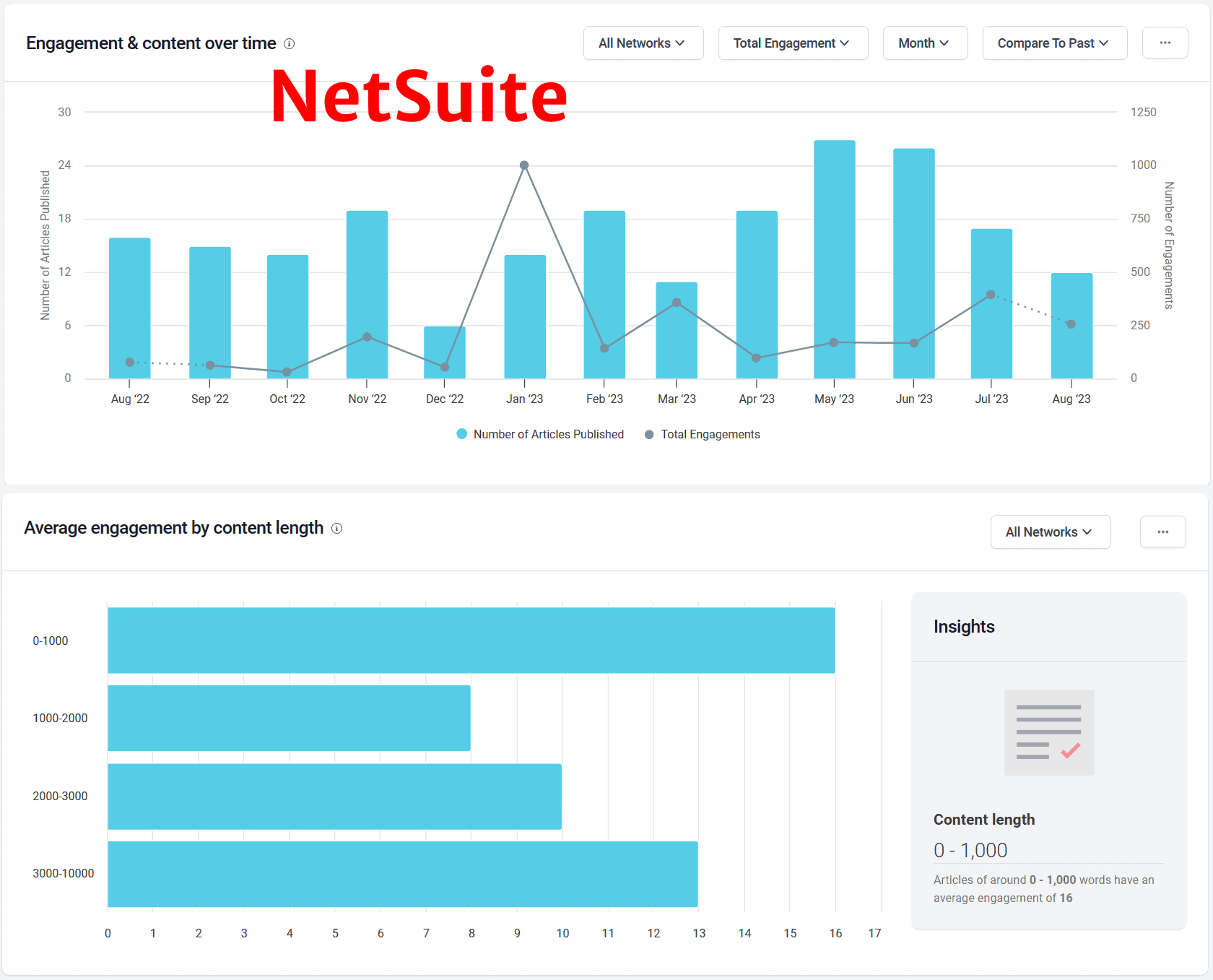
Judging from NetSuite’s content strategy, it appears the audience looking for business management information has tons of questions, and you need to publish 15-25 posts a month to craft a place for your business.
However, that doesn’t automatically transfer to other niches. For example, if you offer SEO insights like Backlinko, your audience may have completely different needs:
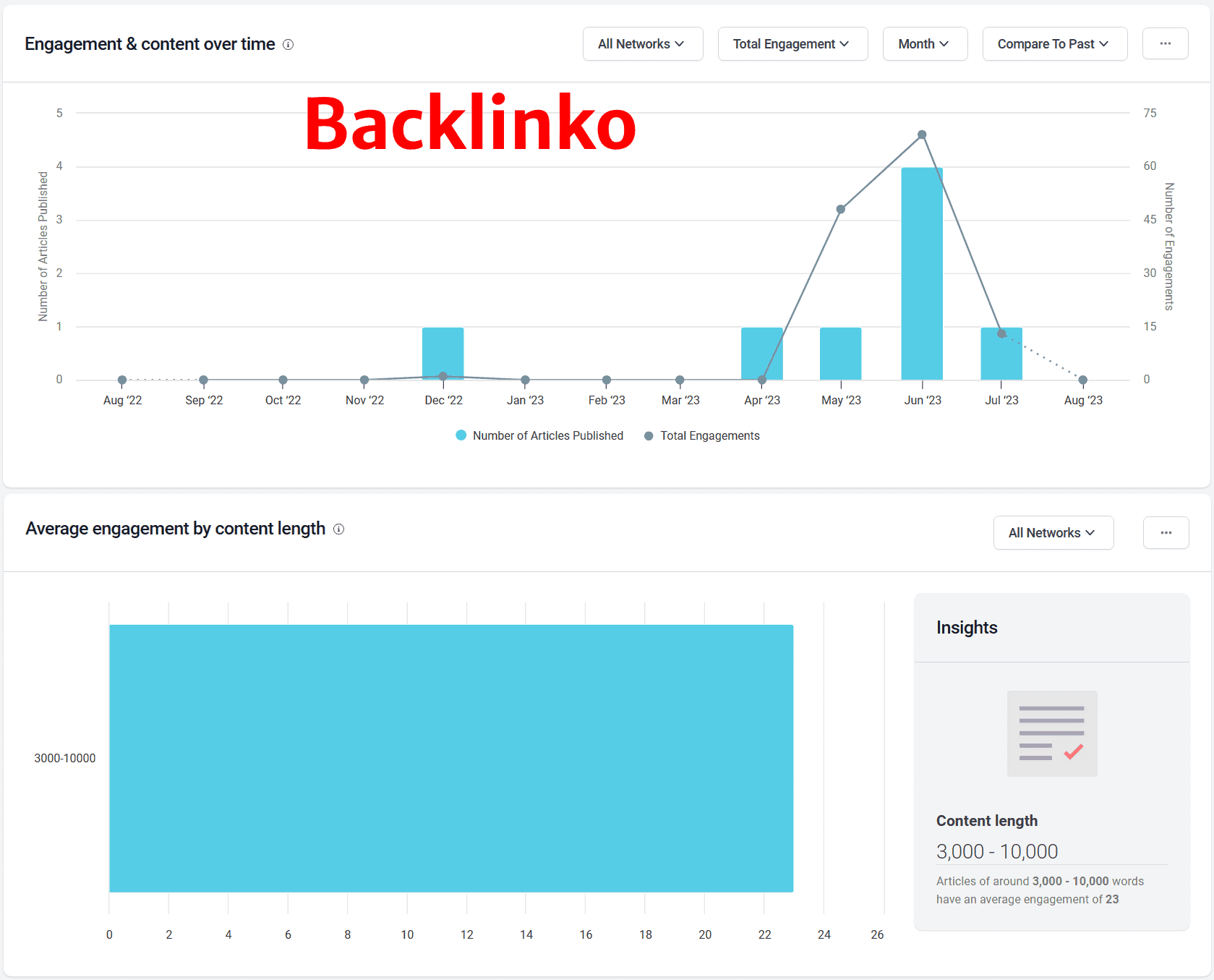
Since Brian Dean has established himself as an authority in the SEO niche and the target audience is a sucker for long-form SEO guides, he can go months without publishing new content while remaining relevant.
Marketing Campaigns
Your marketing efforts, on the whole, also come into play.
For instance, HubSpot recommends that those building their brand start with 1-4 blogs a week to create brand awareness. And to scale it to 3-5 blogs a week once you have established that foundation to generate more organic traffic.
Similarly, you’ll have to occasionally raise your blog post frequency to support your sales channels. For instance, if you’re offering a sale, it’s a great idea to highlight that via a couple of content pieces to get more exposure and drive conversions.
Not to mention, if you’re constantly upgrading your product or services, you can push out a few regular blogs highlighting the new additions to hype up your offerings.
For example, suppose you offer a SaaS tool for email marketing and added services for SMS marketing. In that case, you’ll need to create regular content surrounding SMS marketing to cover all the sales funnel stages.
Brand Voice
What’s your brand personality? Do you want to share spicy takes on viral content or tell data-driven tales?
Creating short, digestible content on emerging trends is often easy. In contrast, collecting data or interviewing subject matter experts to get their insights on the latest industry trends requires more time — hence a longer content frequency.
For example, consider Moz and Ahrefs. While your understanding of both might differ, I consider Moz a helpful, friendly, and community-centric brand. Conversely, Ahrefs comes across as authoritative, technical, and geeky.
And you’ll see these traits translate to their blogs as well.
Moz publishes educational content for new marketers, covers community-related events, and occasionally publishes industry insights about changes in the digital marketing landscape. On the other hand, Ahrefs’s blog features tutorials and how-tos, advanced SEO tips, and news about search engine algorithms.
Since Ahrefs’s approach enables them to release content more frequently, Ahrefs publishes almost double the amount of blog content Moz publishes per month.
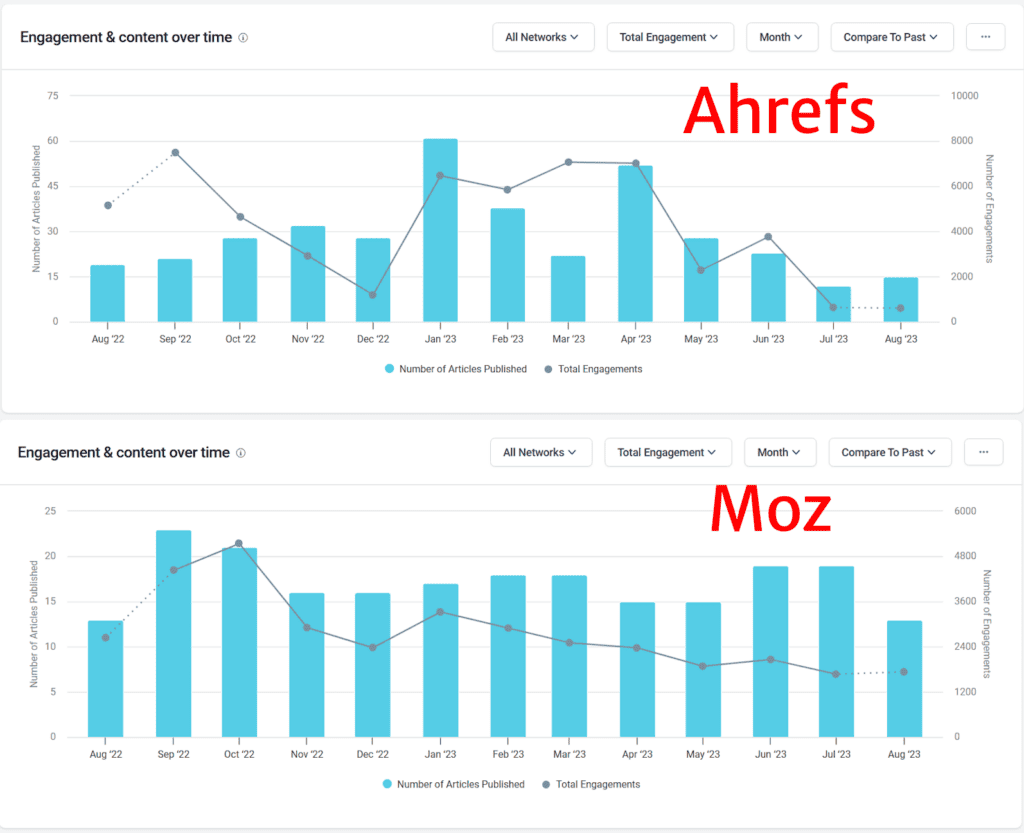
Similarly, you can use other facets of your brand voice to define your content publishing frequency. For instance, if your brand’s core goal is appearing helpful to your audience, creating regular blogs based on the latest industry changes is an excellent idea.
For example, a payroll company that educates its audience about the latest changes in labor laws. Or a WordPress-focused company that keeps its readers up to date by creating posts around the latest core WordPress updates.
Marketing Resources
If you’re the only marketing member on your brand’s team, you can’t expect to publish five or more quality blog posts every week without courting burnout — unless you’re outsourcing content writing.
And even if you’re working with freelancers, you’re not out of the danger zone.
The Content Marketing Institute (CMI) shares that 65% of B2B marketers struggle to find content partners with relevant topical expertise. So, you’ll have to review and edit their work in-house to ensure you don’t end up pushing away your audience by publishing mistake-ridden blogs.
Alternatively, you can consider partnering with an experienced marketing agency like The Blogsmith, which has a team of experts ready to help scale your content marketing efforts without scaling up the headaches.
Content Types
Your content frequency will also depend on the piece of content you’re trying to push. If you deal with timely content, such as a news post following a WordPress update, you’ll need to publish that right after the update.
And if you’re after leads, you’ll need to prepare gated content like infographics, ebooks, or reports with certain cycles (quarter or yearly) that take more of a lift from the content team to complete.
In contrast, if you want to drive traffic by publishing evergreen content like time management tips, you don’t have to stick to a strict timer or reserve more marketing resources.
That said, a successful content marketing strategy often combines various content types, so maintain a content frequency that helps you publish the most optimal content at the appropriate time.
The best way to do so is by planning content in advance. In other words, start working on shareable assets months before the publishing date instead of taking everything off the publishing workflow at the eleventh hour.
Traffic Engagement
Deciding on the best content frequency for your blog isn’t a one-and-done process. Instead, you’ll have to track audience engagement and find your sweet spot.
For example, if your audience is begging you for more posts on your social channels, you shouldn’t leave them hanging.
The opposite is also true — if publishing 7+ posts every week doesn’t get you the traffic numbers you’re looking for, consider reducing the number of posts and focusing your free time on preparing lead magnets.
In short, tweak your content marketing strategy according to the audience’s response.
Maintaining a Publishing Schedule: Best Practices
Even after finding the magic blog post number for your industry, sticking to a strict publishing schedule can be overwhelming. That said, you can start off on the right foot by adopting the following best practices:
Create a Feasible Editorial Calendar
Instead of spending multiple hours brainstorming topics to write about every week, you should optimize your content process by planning for several months using an editorial calendar.
An editorial calendar lets your content team visualize the content workflow — content topic, type of content, and estimated deadline — and see who’ll be working on which project months from now.
This way, you have predictable content requirements to work with, and you don’t have to put the news-focused posts on the side burner just to create a Black Friday post at the last minute.
Plus, it enables you to strategize to scale up content production when required — with in-house resources or otherwise — as you have a bird’s eye view of the marketing timeline.
If you’re struggling with content ideas, check out The Blogsmith’s custom blog calendar service. We help you with content ideas and provide keyword research, relevant briefs, and royalty-free featured images with each idea.
Repurpose Content
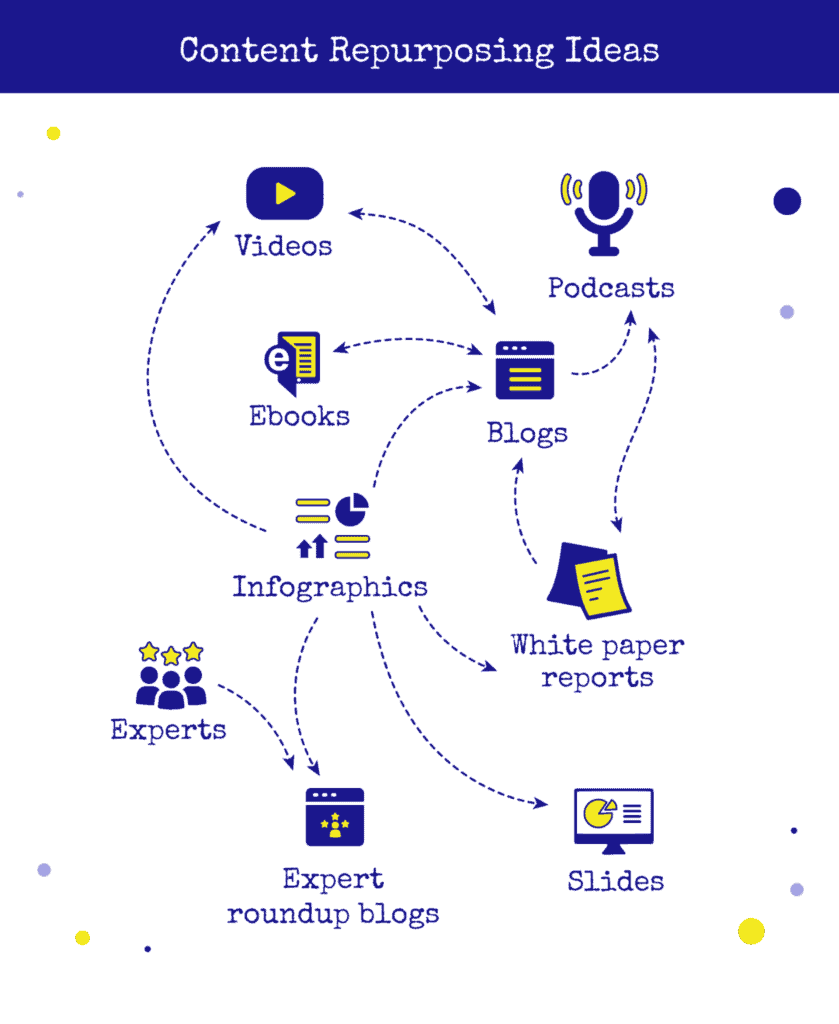
You don’t always have to create content from scratch. Instead, you can reformat existing high-quality content to create other types of valuable content.
Here are a few content repurposing ideas:
- Combine old blog posts to create ebooks
- Convert takeaways from a report into a shareable infographic
- Request experts for their thoughts on the data in the infographics and package the result as an expert roundup post
- Use videos to create new blog posts
- Create presentation slides by drawing inspiration from the infographic and use it to host a webinar
Outsource Content Writing
According to a 2022 Content Marketing Institute (CMI) report, 57% of the most successful content marketers outsource their content creation efforts to freelancers or marketing agencies.
So, if you’re having trouble maintaining the blog posting schedule with the in-house marketing team, turn to content partners outside the company.
But should it be freelancers or marketing agencies? The answer depends on your exact requirements.
Consider freelancers if you want help with one-off projects and have editors and SEO experts on your team.
But an agency seems a better fit if you want a hands-off approach — the content partner handles everything, including topic brief, keyword research, expert insights, and CMS upload.
Final Thoughts: Content Frequency Question — How Often Should You Blog?
While the exact number of blogs you must get out every week depends primarily on your resources and goals, you should keep those numbers consistent to succeed in your content marketing strategy. Otherwise, you’ll have cracks in your sales pipeline.
That said, managing a consistent content frequency throughout the year can be overwhelming. If you’re looking for a content partner who can offload all these tasks, contact The Blogsmith — an SEO content agency packed with experts.












